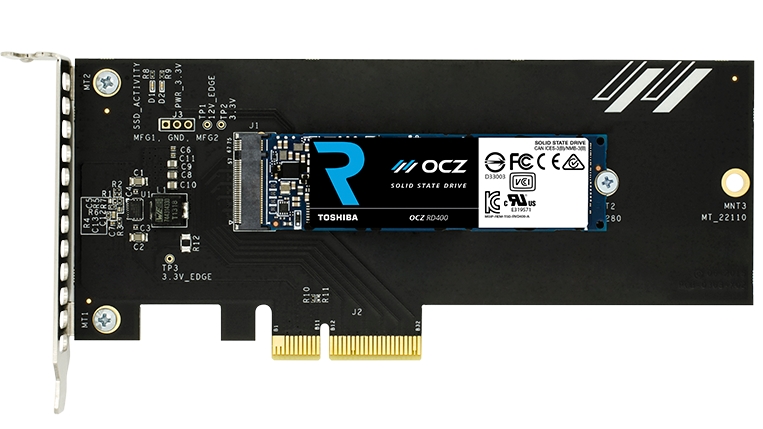TechRadar Verdict
One of the fastest SSDs you can buy today – but not quite the fastest.
Pros
- +
Very fast
- +
PCI adaptor included
- +
No SATA bottleneck
- +
Range of sizes
Cons
- -
Expensive
- -
Not the fastest SSD out there
- -
Not suitable for all users
Why you can trust TechRadar
Standard SATA III solid state drives (SSDs) already bring performance benefits over traditional hard drives, so when a drive comes along that promises 4.5x the speed of an SSD, as the Toshiba OCZ RD400 512GB does, you sit up and take notice.
Unlike standard SSDs and modern HDDs that plug into the SATA III ports of your motherboard, the Toshiba OCZ RD400 512GB can plug into a PCIe or M.2 port of your motherboard. Most modern motherboards in desktop and laptop PCs will have these ports, so unless you’re using very antiquated hardware, you should be able to install the Toshiba OCZ RD400 512GB without a problem.
The SATA III ports of a motherboard were really designed for traditional hard drives, so although SSDs bring performance increases, their performance is being bottlenecked by the connection – and this is why most modern SSDs peak at around 520MB/s write, 560MB/s read, speeds. To put this in perspective, the Toshiba OCZ RD400 512GB, which avoids the SATA ports, can get up to speeds of 2,600MB/s read, 1,600 MB/s write. That’s a huge difference.
This does mean you’re going to be paying more cash for this performance. The Toshiba OCZ RD400 512GB costs £315 (around $385, AU$500), which is around the same price as the Kingston 1TB SSDNow KC400, which costs £320 (around $400, AU$520). Similar price, but half the capacity. However, it’s all about speed, and that means over three times the speed for sequential write tasks, and over five times the speed for sequential read tasks.
Put simply, this is an SSD for enthusiasts that place speed over anything else. If you’re looking for a large capacity hard drive to store photos or slap into a NAS, then this is not the drive for you.

Features and specification
The Toshiba OCZ RD400 512GB uses the M.2 interface on your motherboard which bypasses the aging SATA III ports that most standard SSDs and HDDs use. If you don’t have a motherboard with an M.2 connection (though most modern ones should), the Toshiba OCZ RD400 512GB also comes with a PCI-E adaptor, for slotting in the drive there.
The NVMe interface further helps speeds by reducing latency in the I/O path between the drive and the CPU of your machine, making this a potentially very fast drive.
When active the Toshiba OCZ RD400 512GB has a power consumption of 6.0w, which means this is a pretty efficient SSD, and endurance-wise it has a service life of 296TB total bytes written (with the 1TB model having 592TB TBW). A mean time between failures of 1.5 million hours, and SMART support gives us confidence that this is a reliable SSD that can be used every day for intensive tasks.
Performance
To make sure we tested the Toshiba OCZ RD400 512GB to its full ability we installed it in the M.2 port of a Maximus VIII Extreme Intel Z170 motherboard with the latest UEFI BIOS installed, Windows 10, and the Intel NVMe driver.
We ran a number of benchmarks on the Toshiba OCZ RD400 512GB to see how it coped under pressure. The results were very impressive, with the drive hitting speeds of 2606MB/s read and 1444MB/s write in our sequential tests using the CrystalDiskMark.
These are incredibly fast speeds when you compare it to modern SATA III SSDs such as the Kingston 1TB SSDNow KC400, which hit 560.8MB/s read and 536.6MB/s write speeds. A fairer comparison would be to the Samsung NVMe SSD 960 Pro M.2, which uses the same M.2 connection.
Here the Samsung beat the Toshiba OCZ, reaching phenomenal speeds of 3480MB/s read, 2100MB/s write – quite a difference, though the Samsung is more expensive ($329.99, £270, AU$430 for the 512GB version).
Still, the Toshiba OCZ RD400 512GB represents a huge performance leap over SATA III drives, though if you’re spending this much already on an M.2 drive, you may think the extra outlay for the faster Samsung is worth it.
The ATTO benchmark, which is a reliable tool for testing the read and write speeds of a hard drive using various file sizes, also provided some very impressive results, with top speeds of 2670MB/s read and 1600MB/s write speeds.

Matt is TechRadar's Managing Editor for Core Tech, looking after computing and mobile technology. Having written for a number of publications such as PC Plus, PC Format, T3 and Linux Format, there's no aspect of technology that Matt isn't passionate about, especially computing and PC gaming. He’s personally reviewed and used most of the laptops in our best laptops guide - and since joining TechRadar in 2014, he's reviewed over 250 laptops and computing accessories personally.
